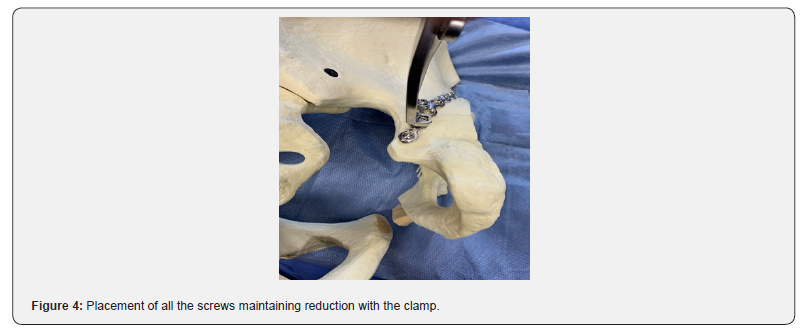Plate-Clamp Assisted Reduction of the Posterior Column of a Displaced Acetabular Fracture- Technical Note
Varatharaj Mounasamy1*, Kendall Anigian2, Kshitij Manchanda3, Sushruthi Vartharaj4, Jibanananda Satpathy5 and Sambandam Senthil6
1Professor of Orthopedics at UTSW, Orthopedic Chief at Dallas VAMC, USA
2Orthopedic Resident,UT Southwestern,Dallas,USA
3Orthopedic surgeon, Miami Orthopaedics and Sports Medicine Institute, USA
4Medical student, Burrell College of Osteopathic Medicine, Las Cruces, New Mexico
5Department of Orthopaedic Surgery, Virginia Commonwealth University Health, USA
6Department of Orthopedics, VA Medical center, USA
Submission:August 23, 2020; Published:September 02, 2020
*Corresponding author: Vartharaj Mounasamy MD, Professor of Orthopedics at UTSW, Orthopedic Chief at Dallas VAMC, Dallas, Texas, USA
How to cite this article: Varatharaj M, Kendall A, Kshitij M, Sushruthi V, Satpathy J, et al. Plate-Clamp Assisted Reduction of the Posterior Column of a Displaced Acetabular Fracture- Technical Note. Ortho & Rheum Open Access J. 2020; 16(5): 555950.10.19080/OROAJ.2020.16.555950
Abstract
We describe a novel method of plate-clamp assisted reduction of the displaced posterior column component of a transverse acetabular fracture. This technique allows fixation of the fracture with the fracture reduced with the plate applied simultaneously during reduction.
Keywords: Posterior column; Clamp
Introduction
Acetabular fractures usually occur after high energy trauma and significant percent of these fractures need open reduction and internal fixation. Surgical approach is determined by fracture obliquity and the column which is maximally displaced [1]. Kocher-Langenbeck approach is chosen if posterior column component is maximally displaced or if an associated transverse and posterior wall fracture pattern is present and in addition to few other situations like a segmental posterior column fracture.
Kocher- Langenbeck can be performed in lateral or prone position. Positioning of the patient is dependent on surgeon familiarity, experience and his/her fellowship training. Patient’s associated injuries like rami fractures/bladder injury and associated cervical spine injury also play an important role in positioning. Prone positioning helps with ease in reduction of the fracture. Trochanteric flip osteotomy in prone position is difficult if needed to be performed for an associated femoral head fracture [2] (Table 1). Inaccurate reduction of acetabular fracture has been reported in lateral position [3]. Anterior column can be fixed with a separate screw or a second plate in the posterior column can aid in stability [4].
Surgical Technique
We describe a plate-clamp assisted reduction technique of the displaced posterior column component of the transverse fracture done through a Kocher-Langenbeck approach. Clamp assisted reduction of the fracture with Jung luth /Farabeuf clamp is well known among acetabular surgeons and is commonly used (Figure 1). After reduction with a clamp, in some cases (Particularly with an associated Posterior wall fracture) there is not enough space for a plate to be placed. This will require use of a Kirschner wire to hold the reduction achieved by the clamp and remove the clamp which could lead to loss of reduction. This is also further made difficult in the lateral position due the weight of the limb causing displacement /medialization of the distal fragment. Hence, we describe this new technique wherein the fracture is reduced with the plate with clamp in-situ.
We describe a technique
Step 1. Drill a hole and place one 3.5 mm screw (6 mm longer than measured length with leaving 4mm proud) proximal to the fracture.
Step 2. Drill a hole and place one 3.5 mm screw (8 mm longer than measured length with leaving 4mm proud) through the 5th hole of low profile under -contoured six-hole pelvis reconstruction plate distal to the fracture (Figure 2).
Step 3. Anatomically reduce the fracture-using a Jung luth clamp with one prong in screw described in step 1 and one prong over the plate/screw described in step 2. Confirm reduction palpating the retro-acetabular surface and using fluoroscopy (Figure 3).
Step 4. Complete screw placement in hole 1 ,2, 3 and 6 (Figure 4).
Step 5. Remove clamp, check reduction and place screw of appropriate length in hole 5 of six-hole plate (Figure 5).
Step 6. Remove screw placed in step 1.
Step 7. Confirm reduction palpating the retro-acetabular surface and using fluoroscopy.






Conclusion
The plate-clamp assisted reduction technique (Mounasamy Technique) of the displaced posterior column component which we describe allows the reduction to be stabilized with the plate immediately before removal of the clamp.
Disclosure Statement
None of the authors have anything to disclose. None of the authors have any conflict of interest.
References
- Letournel E, Judet R (1993) Fractures of the acetabulum. 2ndedn, Springer, Verlag, Berlin, Germany.
- Cutrera NJ, Pinkas D, Toro JB (2015) Surgical approaches to the acetabulum and modifications in Technique. J Am AcadOrthop Surgeons23(10):592-603.
- Collinge C, Archdeacon M, Sagi H (2011) Quality of radiographic reduction and perioperative complications for transverse acetabular fractures treated with a Kocher-Langenbeck approach: Prone versus lateral position. J Orthop Trauma25(9): 538-542.
- Fahmy M, Karim MA, Khaled SA, Ahmed Hazem Abdelazeem, Walid A Elnahal, et al. (2018) Single versus double column fixation in transverse fractures of the acetabulum: A randomised controlled trial. Injury Intl JCare Injured49(7): 1291-1296.






























